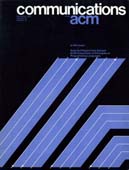December 1975 - Vol. 18 No. 12

Features
Programming languages, natural languages, and mathematics
Some social aspects of pro gramming are illuminated through analogies with similar aspects of mathematics and natural languages. The split between pure and applied mathematics is found similarly in programming. The development of natural languages toward flexionless, word-order based language types speaks for programming language design based on general, abstract constructs. By analogy with incidents of the history of artificial, auxiliary languages it is suggested that Fortran and Cobol will remain dominant for a long time to come. The most promising avenues for further work of wide influence are seen to be high quality program literature (i.e. programs) of general utility and studies of questions related to program style.
Exception handling: issues and a proposed notation
This paper defines exception conditions, discusses the requirements exception handling language features must satisfy, and proposes some new language features for dealing with exceptions in an orderly and reliable way. The proposed language features serve to highlight exception handling issues by showing how deficiencies in current approaches can be remedied.
The intrinsically exponential complexity of the circularity problem for attribute grammars
Attribute grammars are an extension of context-free grammars devised by Knuth as a mechanism for including the semantics of a context-free language with the syntax of the language. The circularity problem for a grammar is to determine whether the semantics for all possible sentences (programs) in fact will be well defined. It is proved that this problem is, in general, computationally intractable. Specifically, it is shown that any deterministic algorithm which solves the problem must for infinitely many cases use an exponential amount of time. An improved version of Knuth's circularity testing algorithm is also given, which actually solves the problem within exponential time.
On the complexity of LR(k) testing
The problem of determining whether an arbitrary context-free grammar is a member of some easily parsed subclass of grammars such as the LR(k) grammars is considered. The time complexity of this problem is analyzed both when k is considered to be a fixed integer and when k is considered to be a parameter of the test. In the first case, it is shown that for every k there exists an O(nk+2) algorithm for testing the LR(k) property, where n is the size of the grammar in question. On the other hand, if both k and the subject grammar are problem parameters, then the complexity of the problem depends very strongly on the representation chosen for k. More specifically, it is shown that this problem is NP-complete when k is expressed in unary. When k is expressed in binary the problem is complete for nondeterministic exponential time. These results carry over to many other parameterized classes of grammars, such as the LL(k), strong LL(k), SLR(k), LC(k), and strong LC(k) grammars.
A fast and usually linear algorithm for global flow analysis (abstract only)
ible graphs is presented. The algorithm is shown to treat a very general class of function spaces. For a graph of e edges, the algorithm has a worst case time bound of O(e log e) function operations. It is also shown that in programming terms, the number of operations is proportional to e plus the number of exits from program loops. Consequently a restriction to one-entry one-exit control structures guarantees linearity. The algorithm can be extended to yet larger classes of function spaces and graphs by relaxing the time bound. Examples are given of code improvement problems which can be solved using the algorithm.
Reduction: a method of proving properties of parallel programs
When proving that a parallel program has a given property it is often convenient to assume that a statement is indivisible, i.e. that the statement cannot be interleaved with the rest of the program. Here sufficient conditions are obtained to show that the assumption that a statement is indivisible can be relaxed and still preserve properties such as halting. Thus correctness proofs of a parallel system can often be greatly simplified.
Automatic data structure choice in a language of very high level
SETL is a set-theoretically oriented language of very high level whose repertoire of semantic objects includes finite sets, ordered n-tuples, and sets of ordered n-tuples usable as mappings. This paper describes the structure of an optimizer for this language. Among other methods of interest, the optimizer uses techniques which allow relations of inclusion and membership to be established, the domains and ranges of (tabulated) mappings to be estimated from above and below, and the single-valuedness of (tabulated) mappings to be proved. Once facts of this kind have been established, automatic choice of data structures becomes possible. The methods employed are based upon, and extend, known techniques of data flow analysis.



